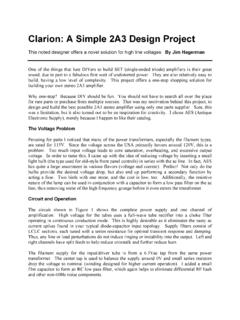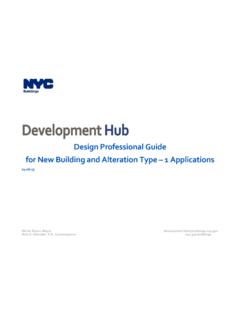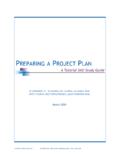Transcription of Design-Build vs. Traditional Construction: Risk and ...
1 Design-Build vs. Traditional construction : Risk and Benefit Analysis I. project Delivery Method Options and Answers A. The Traditional Approach: design /Bid/ build In the Traditional project , an owner selects an architect or engineer to design plans and specifications. See Figure 1, below. The design professionals analyze the owner's needs and develop design concepts. They then prepare design development drawings, and then construction drawings. Once the design has been fully completed and the construction drawings finished and reviewed by the owner, the project is advertised for bids. Contractors pick up the bid solicitation materials and review a full set of plans and specifications to prepare a bid proposal. If the contractor's price is acceptable, the owner will sign a contract with the contractor and construction can then begin. B. When Fast Track construction Works Best In contrast, with fast track construction , the contractor is selected early in the process -- long before the plans and specifications are complete, and sometimes before the design has even begun.
2 The contractor assists with design development and submits a price proposal before the drawings are complete. Usually, the contractor provides a guaranteed maximum cost, including the contractor's fee, and perhaps some contingencies and allowances. construction starts well before the construction drawings are finished. The designers focus first on the site work, and foundation. While the contractor is moving dirt, and constructing the foundation, the designers prepare drawings for the rest of the project . Some of the design may even be design build (more on that later). As PAGE 1. construction progresses, the designers struggle to keep ahead of the contractor. If all goes well, the fast tracked project will complete in much less time than the Traditional project . The principal advantage of fast track construction is time. The project starts well before the completion of the design and may even finish shortly after the last drawing is released.
3 If all goes well, a project that is fast tracked may complete before the construction contract is even signed on a Traditional project . For those projects where time is real money, fast tracking is an option. If a manufacturing plant is needed yesterday, and construction has not yet begun, fast tracking may be viable. In the 1970's when inflation was out of control, fast tracking helped to avoid some of the price increases. Fast tracking also allows the contractor an early opportunity to provide design input and value engineering. The relationship between the parties should be less confrontational since the contractor is usually not bound to a fixed lump sum price. However, fast tracking is not cheap and has considerable risks. New drawings arrive about every day. There may be coordination problems between drawings, or with existing construction . The contractor is not always able to construct exactly what is shown on the drawings due to field or existing conditions.
4 When the contractor makes changes, the changes need to be immediately communicated to and coordinated with the designer. C. The Inherent Challenges in Multiple Primes Well into the 1800's, the primary approach to construction was the master builder who not only designed the project , but also constructed it. For most of this century, however, construction projects have been managed jointly by the triumvirate of the owner, designer, and general contractor. PAGE 2. Under this approach, the contractor and designer typically exercised day to day control, although the owner has at least nominal control, thanks to the power of its purse. (Remember the Golden Rule: He who has the gold makes the rules.) This Traditional approach involved a single prime contractor who contracted directly with the owner. The general contractor then signed subcontracts with key trade contractors (electrical, mechanical, plumbing, etc.)
5 , and acted as the site manager during construction . See Figure 1. The general contractor answered for the quality, cost, and timeliness of the work. The general contractor also assumed responsibility for site safety. The designer traditionally observed the construction to verify general conformance with the plans and specifications and the other contract documents. The designer also visited the site to determine the percentage of completion and to assess the propriety of the contractor's applications for payment. In a multiple prime arrangement, the owner hires various prime contractors (usually, the trade contractors, electrical, mechanical, plumbing, etc.) to perform and control the different portions of the work. There is no general contractor. Each prime contractor is independently responsible to the owner for the cost, timeliness, and quality of the work under its respective contract. The owner acts as its own general contractor or hires a construction manager to control the project .
6 See Figure 2. Under this approach, the various prime contracts must clearly define responsibilities for construction , supervision of the work, site safety, and contract administration, since accountability for the whole of the work is now fragmented among several entities. If the owner is not a sophisticated and effective manager, retaining multiple primes is an accident waiting to happen. Coordination problems are bound to arise if the work of each trade contractor is not scheduled appropriately. If the trade contractors mobilize only to discover that the PAGE 3. project has not progressed sufficiently to accommodate them, or that another trade has had to disturb their work to do their own, there may be significant delay and disruption claims, and massive litigation. For example, in Maintenance Corp. v. Rutgers, 90 223, 447 906 (1982), the owner's contracts with each of several primes stated that time was of the essence.
7 When delays occurred, and complex litigation began, the court held that each prime contractor was an intended beneficiary of the owner's contracts with the other primes and had standing to sue the others for delay damages. The single biggest winners there were the lawyers. Choosing multiple primes may save a substantial amount of money. Typically, the general contractor marks up the costs of its subcontractors and materials. This markup covers the general contractor's administration costs and some of its risks. Often, in negotiating the subcontract prices (known in the trade as buying out the subcontracts ), the general contractor will reap considerable savings over its estimated costs. With multiple primes, the owner benefits directly from any savings on subcontract buyout, and avoids the general contractor's markup on subcontracts and materials. D. Common Setbacks Arising in design / build Contracting While the design build concept is not new, its expansive use is a recent phenomenon.
8 The Texas Education Code, , now allows schools to make widespread use of design building. Section permits schools to avoid competitive bidding for school construction projects by contracting for a design built school. There are several variations of the design build concept, but the two main approaches are the design build Team, and Sole design Builder. 1. design build Team Under the design build Team approach, an architect or engineer and a contractor join forces PAGE 4. to form a joint venture to design and build a project . The team negotiates with an owner or submits a competitive proposal for both the project 's design and construction . An advantage of this approach is the early involvement of the general contractor in the design phase. Having the contractor involved early allows for better coordination with the designer and among the various aspects of the design . The contractor and designer are motivated to work and play well together since they are team members.
9 This can also be a disadvantage. The designer no longer is principally the owner's agent, and is partners with the contractor. This disadvantage can also be an advantage if the owner makes both designer and contractor responsible for the ultimate project . The owner can then look to the team if anything is amiss, and avoid finger pointing between designer and contractor. 2. Sole design Builder Under this approach, one firm contracts with the owner to be responsible for both the design and construction of the project . That firm then retains design expertise and construction capability suitable for the project . An advantage is a greater turn key approach with one firm responsible for the entire project . Another advantage is the firm's ability to specialize in particular projects, like schools. Building a great number of a particular type of project gains the firm a verifiable track record. The owner can inspect prior projects for imagination, form, and function.
10 A disadvantage is the lack of independent and critical analysis from separate design and construction firms. This disadvantage has less impact if the owner has some expertise and can capably review the design and construction of the project . 3. design build Developer With this approach, the owner contracts with a commercial developer, who usually lacks the credentials of a designer or a contractor. This approach is suitable for the owner who has little or PAGE 5. no construction experience, and owns few other projects. The design build developer can supply the expertise to oversee the design and construction of projects for those owners who lack the necessary in-house staff. This way the owner can retain the experience necessary to develop the project properly, from selection of designer and contractor to handling of governmental permits and other matters. This form of design building is often used for build to suit projects.




